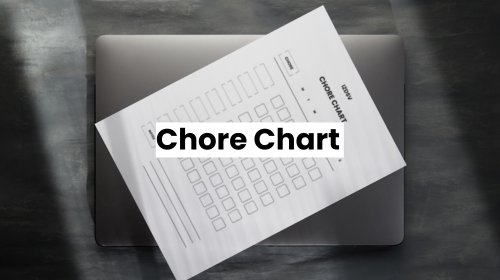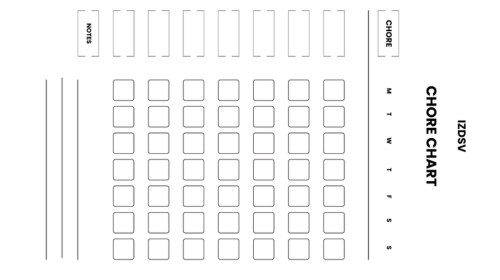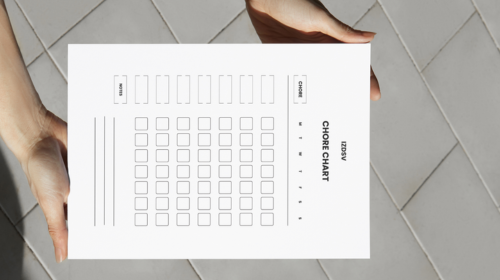Color Code Chore Chart Template: Color Code for Family
Introduction to Chore Charts
Chore charts are organizational tools that help families distribute household responsibilities fairly among family members. They serve as visual reminders and tracking systems that can transform chaotic household management into structured, manageable routines.
- Create accountability by making expectations clear and visible to everyone
- Establish consistent routines that become automatic habits over time
- Reduce daily negotiations and arguments about who should do what tasks
- Teach valuable life skills and responsibility to children from an early age
- Help busy families stay organized and ensure important tasks don’t get forgotten
What is a Chore Chart?
A chore chart is a visual system that lists household tasks and assigns them to specific family members, often including tracking mechanisms for completion. These charts can range from simple paper lists to elaborate digital systems with rewards and progress tracking.
- Physical charts using poster boards, whiteboards, or printed templates
- Digital apps and online platforms with reminder notifications
- Magnetic charts with movable pieces for task rotation
- Calendar-based systems that integrate chores with family schedules
- Point-based systems that track completion and tie to rewards
- Age-appropriate task assignments that grow with children’s capabilities
Benefits of Using Chore Charts
Chore charts provide structure that reduces household stress while teaching important life lessons about responsibility and teamwork. Research shows that children who participate in household chores develop stronger work ethics and better problem-solving skills as adults.
- Distribute workload fairly so no single person feels overwhelmed
- Build children’s confidence through completed tasks and recognized contributions
- Develop time management skills as family members learn to plan around responsibilities
- Strengthen family bonds through shared ownership of the household
- Reduce parental nagging by transferring responsibility to the chart system
- Prepare children for independent living by teaching essential life skills
- Create opportunities for earning privileges or allowances through completed work
- Establish clear consequences that are tied to actions rather than emotions
Understanding Color Coding in Chore Charts
Color coding transforms ordinary chore charts into intuitive visual systems that make task management more efficient and appealing. This organizational method uses different colors to represent various categories, family members, or priority levels, making it easier for everyone to identify their responsibilities quickly.
- Creates instant visual recognition that eliminates the need to read through entire lists
- Appeals to visual learners who process information better through colors than text
- Makes charts more engaging and less intimidating, especially for children
- Allows for quick scanning to identify overdue or completed tasks
- Helps organize complex household systems with multiple people and task types
- Reduces confusion when multiple family members share similar responsibilities
- Enables easy identification of patterns in task completion or avoidance
Why Use Color Coding?
Color coding leverages the brain’s natural ability to process visual information faster than text, making chore charts more user-friendly and effective. Studies show that color-coded systems reduce task completion time by up to 30% because people can instantly identify what needs their attention.
- Speeds up daily chart checking by allowing quick visual sweeps instead of detailed reading
- Accommodates different learning styles, particularly benefiting visual and kinesthetic learners
- Reduces cognitive load by eliminating the mental effort required to process text-heavy lists
- Creates emotional associations with colors that can motivate task completion
- Enables immediate identification of task categories without reading descriptions
- Helps busy parents quickly assess household task distribution and completion status
- Makes it easier to spot patterns in procrastination or task avoidance behaviors
- Supports non-readers and early readers who can still participate through color recognition
Choosing the Right Colors for Different Chores
Strategic color selection can enhance the effectiveness of your chore chart by creating logical associations and emotional responses. The psychology of color suggests that certain hues naturally align with specific activities and can influence motivation levels and task perception.
- Use blue for cleaning tasks as it psychologically represents cleanliness and calm
- Assign green to outdoor or pet-related chores since it connects with nature
- Choose red for urgent or time-sensitive tasks that require immediate attention
- Select yellow for kitchen duties as it’s associated with warmth and nourishment
- Apply purple for creative or organizational tasks like room decoration or sorting
- Use orange for physical activities like taking out trash or moving heavy items
- Assign each family member a personal color to track individual responsibilities
- Consider seasonal color rotations to maintain interest and prevent visual fatigue
- Avoid using too many colors as this can create confusion rather than clarity
- Ensure color choices work for colorblind family members by using different shades or patterns
Types of Chore Charts
Chore charts come in numerous formats and styles, each designed to meet different family needs, preferences, and organizational approaches. The variety available ensures that every household can find a system that matches their lifestyle, technology comfort level, and motivational strategies.
- Traditional paper-based charts that use stickers, checkmarks, or magnetic pieces
- Digital applications and software programs accessible on phones, tablets, and computers
- Hybrid systems that combine physical charts with digital tracking and reminders
- Reward-based charts that incorporate point systems, allowances, or privilege tracking
- Age-specific designs tailored for toddlers, school-age children, or teenagers
- Seasonal or themed charts that rotate designs to maintain engagement
- Simple daily task lists for families preferring minimal visual complexity
- Complex weekly or monthly systems for households with elaborate chore rotations
Printable Chore Chart Templates
Printable templates offer the perfect balance of customization and convenience, allowing families to create professional-looking charts without design skills or software expenses. These ready-made formats can be downloaded, personalized with family names and specific tasks, then printed at home for immediate use.
- Available in countless designs from simple grids to elaborate themed graphics
- Often include pre-written age-appropriate chore suggestions to save planning time
- Can be customized with family names, specific tasks, and personal reward systems
- Cost-effective solution that requires only paper, printer, and basic office supplies
- Allow for easy replacement when charts become worn or family needs change
- Available in various sizes from small personal charts to large family wall displays
- Include both basic black-and-white options and colorful decorated versions
- Often feature spaces for tracking completion dates, points earned, or rewards claimed
- Can be laminated for durability and reuse with dry-erase markers
- Readily available from parenting websites, educational resources, and organizational blogs
Digital and Editable Chore Charts
Digital chore charts represent the modern evolution of household organization, offering interactive features and technological conveniences that traditional paper charts cannot match. These systems often integrate with family calendars, send automatic reminders, and provide detailed analytics about task completion patterns.
- Automatically send push notifications and email reminders for upcoming or overdue tasks
- Sync across multiple devices so family members can check progress anywhere
- Include photo verification features where children can submit pictures of completed chores
- Offer gamification elements like badges, levels, and leaderboards to increase motivation
- Provide detailed analytics showing completion rates, streak tracking, and performance trends
- Allow real-time updates so parents can approve completed tasks while away from home
- Include built-in reward systems that automatically track points and allowance calculations
- Support multiple user accounts with different permission levels for parents and children
- Enable easy task reassignment when family members are sick or have schedule conflicts
- Often include extensive chore libraries with age-appropriate task suggestions and instructions
Using a Family Chore Chart
A family chore chart serves as the central hub for household task management, requiring buy-in from all family members to function effectively. Successful implementation depends on clear communication, consistent enforcement, and regular adjustments to accommodate changing family dynamics and needs.
- Establish clear expectations and consequences before launching the chart system
- Hold a family meeting to explain the chart, assign initial tasks, and address questions
- Start with fewer tasks and gradually add more as the routine becomes established
- Review and adjust task assignments weekly to ensure fairness and age-appropriateness
- Celebrate successes publicly to reinforce positive behaviors and motivate continued participation
- Address chart failures promptly without harsh punishment that might discourage future efforts
- Involve children in creating and modifying the chart to increase ownership and engagement
- Use the chart as a teaching tool for time management, responsibility, and teamwork
- Regularly evaluate whether the current system meets your family’s evolving needs
- Consider seasonal adjustments that account for school schedules, weather changes, and family activities
How to Create Your Own Color-Coded Chore Chart
Creating a personalized color-coded chore chart allows you to design a system that perfectly matches your family’s unique needs, preferences, and household dynamics. This custom approach ensures maximum engagement and effectiveness since the chart reflects your specific tasks, family members, and motivational strategies.
- Begin by listing all household tasks and categorizing them by type, frequency, or family member
- Select a color scheme that makes logical sense to your family and accommodates any color vision limitations
- Choose your preferred format whether physical poster board, laminated template, or digital platform
- Decide on tracking methods such as stickers, checkmarks, magnetic pieces, or digital completion buttons
- Establish clear reward systems or consequences tied to chart completion rates
- Plan for regular review sessions to adjust tasks, colors, or family member assignments
- Create backup plans for when family members are sick, traveling, or have schedule conflicts
- Design age-appropriate visual elements that appeal to your children’s current interests and abilities
Step-by-Step Guide to Designing a Chore Chart
The design process requires thoughtful planning to ensure your chart becomes a helpful tool rather than another source of family stress. A well-designed chart balances visual appeal with practical functionality, making it easy for family members to understand expectations and track their progress.
- Gather input from all family members about their preferred tasks, schedules, and reward preferences
- Create a master list of all household tasks including daily, weekly, and monthly responsibilities
- Group similar tasks together and assign each category a distinct color based on logical associations
- Determine the appropriate difficulty and time requirements for each family member’s age and ability
- Sketch your chart layout ensuring adequate space for names, tasks, and completion tracking
- Choose materials that will withstand daily use, such as laminated paper, whiteboard, or sturdy poster board
- Add visual elements like borders, icons, or themed decorations that appeal to your children
- Include clear instructions or legends explaining the color system and completion requirements
- Test the chart for one week and gather feedback before making it the permanent system
- Prepare all necessary supplies like stickers, markers, or magnetic pieces before launching
Using Calendar Templates for Chores
Calendar-based chore charts integrate household tasks with family scheduling, creating a comprehensive system that shows both time commitments and task responsibilities. This approach works particularly well for busy families who need to coordinate chores around school, work, and activity schedules.
- Download monthly or weekly calendar templates that provide adequate space for task entries
- Color-code each family member or task category using highlighters, colored pens, or digital formatting
- Schedule recurring tasks on appropriate days considering school schedules, work commitments, and energy levels
- Block out time estimates for each task to help family members plan their daily routines
- Include seasonal tasks like yard work or holiday preparations in appropriate months
- Add reminder symbols or notes for tasks that require supplies, coordination, or advance preparation
- Integrate family activities and appointments to avoid scheduling conflicts with chore assignments
- Use different symbols or fonts to distinguish between daily maintenance tasks and weekly deep-cleaning projects
- Plan for flexibility by including alternate days for weather-dependent or time-sensitive tasks
- Review and update the calendar monthly to accommodate changing schedules, seasons, and family needs
Tips for Maintaining Chore Charts
Successful chore chart maintenance requires ongoing attention and adaptability to prevent the system from becoming stale or ineffective over time. The key lies in treating the chart as a living document that evolves with your family’s changing needs, schedules, and developmental stages.
- Schedule weekly family meetings to review chart performance and address any emerging issues
- Rotate task assignments monthly to prevent boredom and ensure all family members learn different skills
- Update the chart immediately when tasks are completed to maintain momentum and visual progress
- Address chart violations promptly but fairly, focusing on problem-solving rather than punishment
- Celebrate chart successes publicly through family recognition, special privileges, or small rewards
- Modify difficulty levels as children grow and develop new capabilities and time management skills
- Replace worn or damaged charts before they become illegible or unappealing to use
- Adjust seasonal tasks and expectations to account for school schedules and weather changes
- Maintain adequate supplies like stickers, markers, or replacement pieces to avoid system breakdowns
- Document what works and what doesn’t to inform future chart iterations and improvements
Encouraging Kids to Use the Chore Chart
Children’s enthusiasm for chore charts often wanes after the initial novelty wears off, making ongoing motivation strategies essential for long-term success. The most effective approaches focus on intrinsic motivation while providing enough external structure to maintain engagement during challenging periods.
- Start each new chore chart for kids with a family celebration or special activity to generate excitement and buy-in
- Allow children to choose some of their own tasks from pre-approved options to increase ownership
- Implement a buddy system where siblings can help and encourage each other’s chart completion
- Create chart completion streaks that unlock special privileges or family activities rather than just individual rewards
- Use positive reinforcement by praising effort and improvement rather than only perfect completion
- Make chart checking a fun family ritual with music, special snacks, or favorite family time
- Allow children to personalize their chart sections with stickers, drawings, or photos
- Share stories about how their contributions genuinely help the family function better
- Provide age-appropriate choices in how they complete tasks while maintaining quality standards
- Connect completed chores to larger family goals like saving money for vacations or helping others
Tracking Progress with a Color-Coded System
A well-implemented color-coded tracking system provides instant visual feedback that motivates continued participation while helping families identify patterns and areas needing attention. The tracking method should be simple enough for daily use but comprehensive enough to provide meaningful progress information.
- Use different colored stickers or markers to indicate task completion quality, such as excellent, good, or needs improvement
- Assign completion status colors like green for finished, yellow for in-progress, and red for overdue tasks
- Create weekly progress bars using colored segments to show each family member’s overall completion rate
- Implement a traffic light system where green means ahead of schedule, yellow means on track, and red means behind
- Use color intensity or shading to show task difficulty levels and celebrate achievements accordingly
- Track consecutive completion days with color-coded streak markers that build motivation through visual progress
- Color-code task categories so family members can quickly identify their strongest and weakest performance areas
- Create monthly color summaries that show overall family progress and individual contribution patterns
- Use seasonal color themes to maintain visual interest while preserving the functionality of the tracking system
- Document color-coded progress with photos or digital records to show long-term improvement and family growth




